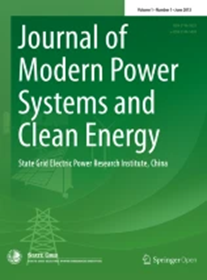基于最小特征值的对数导数法计算大型电力系统的主导振型
IF 6.1
1区 工程技术
Q1 ENGINEERING, ELECTRICAL & ELECTRONIC
Journal of Modern Power Systems and Clean Energy
Pub Date : 2024-11-27
DOI:10.35833/MPCE.2024.000630
引用次数: 0
摘要
随着可再生能源的快速并网,电力电子设备与电网相互作用引起的宽带振荡已成为最关键的稳定性问题之一。现有的方法通常针对100个节点左右的局部电力系统进行研究。然而,对于具有数万个节点的大型电力系统,传递函数矩阵的维数或特征方程的阶数要高得多。在这种情况下,现有的特征值分析法和基于阻抗的方法计算困难,难以在实际中应用。为了填补这一空白,本文提出了一种基于最小特征值的对数导数方法。通过对稀疏扩展节点导纳矩阵(NAM)的最小k个特征值曲线的对数导数,得到了主振型。在此基础上进一步开发了振荡稳定性分析工具。通过一个局部电力系统和一个大型电力系统验证了该方法和工具的有效性。本文章由计算机程序翻译,如有差异,请以英文原文为准。
Smallest Eigenvalues Based Logarithmic Derivative Method for Computing Dominant Oscillation Modes in Large-Scale Power Systems
With the rapid integration of renewable energy, wide-band oscillations caused by interactions between power electronic equipment and grids have emerged as one of the most critical stability issues. Existing methods are usually studied for local power systems with around one hundred nodes. However, for a large-scale power system with tens of thousands of nodes, the dimension of transfer function matrix or the order of characteristic equation is much higher. In this case, the existing methods such as eigenvalue analysis method and impedance-based method have difficulty in computation and are thus hard to utilize in practice. To fill this gap, this paper proposes a novel method named the smallest eigenvalues based logarithmic derivative (SELD) method. It obtains the dominant oscillation modes by the logarithmic derivative of the $k$ -smallest eigenvalue curves of the sparse extended nodal admittance matrix (NAM). An oscillatory stability analysis tool is further developed based on this method. The effectiveness of the method and the tool is validated through a local power system as well as a large-scale power system.
求助全文
通过发布文献求助,成功后即可免费获取论文全文。
去求助
来源期刊

Journal of Modern Power Systems and Clean Energy
ENGINEERING, ELECTRICAL & ELECTRONIC-
CiteScore
12.30
自引率
14.30%
发文量
97
审稿时长
13 weeks
期刊介绍:
Journal of Modern Power Systems and Clean Energy (MPCE), commencing from June, 2013, is a newly established, peer-reviewed and quarterly published journal in English. It is the first international power engineering journal originated in mainland China. MPCE publishes original papers, short letters and review articles in the field of modern power systems with focus on smart grid technology and renewable energy integration, etc.
 求助内容:
求助内容: 应助结果提醒方式:
应助结果提醒方式:


